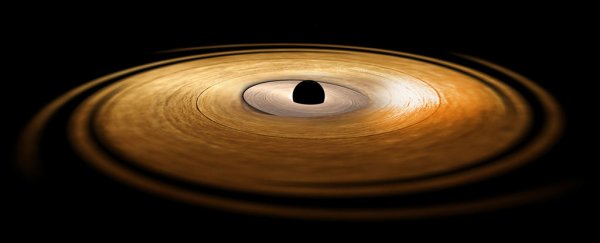An international team of scientists has observed matter wobbling in a gravitational vortex around a black hole for the first time.
The discovery could help settle a long-standing debate about an astronomical phenomenon called quasi-periodic oscillation, as well as help scientists to understand more about how matter behaves in the intense gravitational forces near black holes – and, to that extent, test Einstein's general relativity.
When matter gets sucked into a black hole, it begins to heat up, reaching millions of degrees, at which point it starts to beam X-rays into space.
Back in the 1980s, scientists observed that these X-rays flicker, with the rate of their flickering changing over time. The X-rays dim and then brighten, at first taking 10 seconds to complete a single oscillation, but eventually speeding up as matter gets closer to the black hole, until 10 oscillations occur every second. This phenomenon is called quasi-periodic oscillation (QPO).
"It was immediately recognised to be something fascinating because it is coming from something very close to a black hole," says one of the researchers, Adam Ingram from the University of Amsterdam in the Netherlands.
Astronomers later thought QPOs might be related to the gravitational effect predicted by Einstein's general relativity – basically, that a spinning object could create a kind of gravitational vortex.
"It is a bit like twisting a spoon in honey. Imagine that the honey is space and anything embedded in the honey will be 'dragged' around by the twisting spoon," explains Ingram. "In reality, this means that anything orbiting a spinning object will have its motion affected."
This effect is called Lense–Thirring precession, and the effect would become so fast around black holes, that scientists began to think it could be linked to the flickering of QPOs.
In 2009, Ingram published a paper suggesting that QPOs are driven by Lense-Thirring precession. The hypothesis was that the flat disc of matter surrounding a black hole – called an accretion disc – turns into hot plasma (called the inner flow) as it is sucked into the black hole.
To test if this was actually occurring, Ingram and fellow researchers used two orbital telescopes – the European Space Agency's XMM-Newton and NASA's NuSTAR – to observe the QPO around a black hole called H 1743–322.
After analysing the data, the team discovered that the 'iron line' – a shining light, caused by radiation emitted from the inner flow, which strikes the iron atoms in the matter making up the accretion disc – was indeed wobbling, which matches up with the predictions of general relativity.
"We are directly measuring the motion of matter in a strong gravitational field near to a black hole," says Ingram.
Using the technique – which is the first time that the Lense-Thirring effect has been measured in a strong gravitational field – astronomers will now be able to study the movement of matter in these inner regions of accretion discs surrounding black holes, giving scientists a whole new way to test ideas that up until now have largely remained hypothetical.
"If you can get to the bottom of the astrophysics," says Ingram, "then you can really test the general relativity."
The findings have been published in the Monthly Notices of the Royal Astronomical Society.
